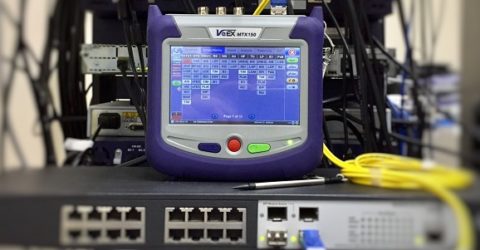What are symmetrical broadband speeds?
Symmetrical broadband speeds represent a key advantage of full fibre broadband services, but how do they work?

When you choose a new broadband deal, there are two main options.
You could choose a company whose services are piped through the Openreach phone line network. This includes most providers – BT, Sky, Plusnet, and so forth.
The alternative is a company that has its own fibre optic cabling network installed in your area. Full fibre brands include Virgin Media, Grain, Hyperoptic and Trooli.
While most consumers still favour networks supplied via Openreach (though some have no choice in the matter), proprietary fibre networks are growing in popularity.
They offer some unique advantages, one of which can only really be understood with a quick history lesson.
A long, long time ago…
Back in the 1990s, dial-up internet represented the only way to get home computers online.
However, connections were pitifully slow, at just 56Kbps.
In an attempt to mitigate this, the concept of asymmetrical broadband speeds arose, with downloads receiving priority over uploads.
It was commonplace for downloads to be ten times faster than uploads – and it still is on today’s ADSL connections.
ADSL speeds are typically around 12Mbps – 500 times faster than dial-up – but you’ll routinely see uploads hovering around 1Mbps.
Why were downloads prioritised?
Consumers tend to live up to their name and consume more than they create.
It’s relatively uncommon to upload videos to YouTube or add your own podcast files to Spotify, whereas most of us will have streamed and downloaded content from these sites.
Even influencers typically spend far more time viewing other people’s content than uploading their own.
Biasing a connection in favour of the most common direction of travel helps to improve end user experiences, minimising the risk of intrusive buffering or gameplay-ruining latency.
So why are symmetrical broadband speeds now seen as beneficial?
The internet has evolved greatly in recent years, and private individuals are uploading data in ever-increasing volumes.
Consider cloud storage. Every time a file is modified locally in Microsoft OneDrive, a mirror file is uploaded to the cloud, overwriting what was there previously.
Higher file quality has also played a part. Freelance photographers who used to email compressed JPG files are now more likely to send RAW files, which are many times bigger.
While we still consume more than we create, there’s a far higher volume of traffic travelling away from our devices – especially in the homes of online gamers.
Every action made on your computer or console has to be uploaded, just as every reciprocal action made by other players has to be downloaded in response.
Clearly, biasing connection speeds 10:1 in favour of downloads is less beneficial than it once was.
How can full fibre platforms offer symmetrical speeds?
Put simply, because their connections are fast enough to cope with any activities users throw at them.
A 12Mbps ADSL connection might struggle if two devices are streaming HD content simultaneously, whereas a 500Mbps full fibre connection wouldn’t break sweat.
Because household connections will rarely be put under significant pressure by downloading content, setting aside 50 per cent of available line capacity for uploads is no sacrifice.
It also means anyone used to ADSL upload times will be staggered by how quickly emails with large attachments vanish from their Outbox, and how rapidly WeTransfer uploads finish.
If you regularly upload files or transfer content into the cloud, a symmetrical connection will be hugely preferable to an asymmetric one.
It’s arguably the biggest single reason to switch from an Openreach-based broadband service to a proprietary full fibre network.






